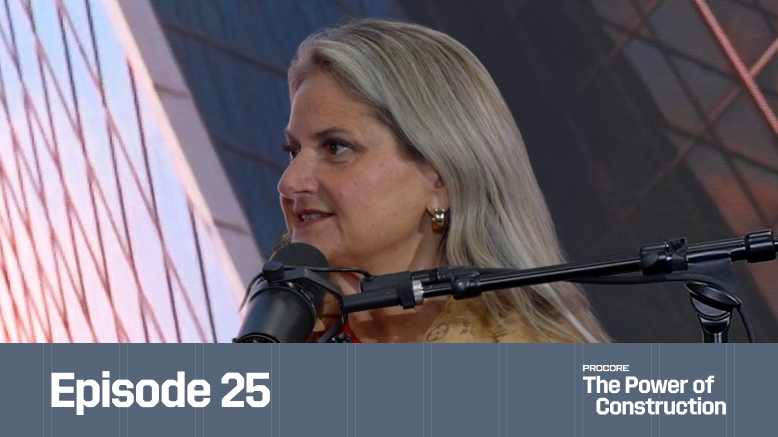— 7 min read
30 minutes max: Streamlining progress meetings for GCs


Last Updated Oct 3, 2025

Dave Brown
Product Success Manager
9 articles
Dave is a Product Success Manager at Procore. Previously, he worked for Consigli Construction Co in Boston and Washington, DC as a Project Engineer and Assistant Project Manager, responsible for a variety of activities including bidding and procurement, contracts, and cost control. Dave holds a Bachelor's Degree in Structural Civil Engineering from Bucknell University.

Kacie Goff
Contributing Writer
91 articles
Kacie Goff is a construction writer who grew up in a construction family — her dad owned a concrete company. Over the last decade, she’s blended that experience with her writing expertise to create content for the Construction Progress Coalition, Newsweek, CNET, and others. She founded and runs her own agency, Jot Content, from her home in Ventura, California.
Last Updated Oct 3, 2025

For an industry that hinges on physically creating a tangible product on the jobsite, construction requires a lot of folks to spend a lot of time sitting in meetings. One particular type of construction meeting often becomes onerous: the progress meeting.
While this sync plays a key role in keeping teams aligned, it can feel overly lengthy and minimally effective. Sometimes, it even feels like meeting to plan the next meeting. The overhead costs of the hours per person per meeting add up for the company, too.
Fortunately, general contractors can take steps to make their progress meetings faster, easier and more efficient. That doesn’t mean ditching the meeting entirely — but GCs can take a different tack to make these stand-ups more useful and less burdensome.
Table of contents
Applying a new framework to progress meetings
Some progress meetings gather more than 50 people in a room in the hopes of getting updates from all of them in an hour or less. That means that most of the folks sit there waiting for their turn, wasting precious minutes in the day.
By applying lean principles, GCs can rework the structure of these meetings to save everyone time (and boredom) while delivering better results. Foremen can get back on the job in 30 minutes, and other stakeholders can process important information to move up the ladder. They can do this with timeboxed 15-minute meetings that gather the right people around an action-oriented agenda.
Start by breaking the progress meeting into 15-minute increments.
0–15 minutes
In the first 15 minutes, crews meet with their specific foremen, providing updates. This allows the team leads to get information about the work from the people closest to it. The equipment operator can flag any maintenance concerns, for example. Crews can then be released to their work with just 15 minutes of their day allocated to the meeting.
15–30 minutes
Hold an all-foreman stand-up in which those team members report back information from each of their crews to the superintendent or other representative from the GC. This makes sure that individual crews are aligned and moving in the same direction. Foremen are then released to their work, having spent only 30 minutes in the progress meeting.
30–45 minutes
The superintendent or other appropriate stakeholder(s) takes what was reported by the foremen and shares it with whoever needs that information higher up the ladder, whether that’s the owner, the architect, the GC’s decision-makers, or someone else.
By the end of 45 minutes, the appropriate information should be reported to the people who need to know about it. This framework allows anything blocking the project’s progress to be identified. More importantly, it notifies the people who can solve the issue so they can start taking action.
For example, maybe the foreman learns about a problem that came up yesterday during the meeting, and they can intervene. But maybe it’s a bigger issue, like equipment breakdown, and the issue needs to be raised with other stakeholders who can help teams workaround the problem. The sequential structure of this progress meeting format helps problems get moved up the ladder to the appropriate height.
This structure also keeps people out of meetings for too long, freeing up time if they need to discuss something further. If a blocker warrants more conversation, they can have a smaller huddle with the necessary team members afterward. And since this structure only demands 30 minutes maximum from any given person, they’re still saving time over the traditional hour-long meeting.
In short, this progress meeting framework enables the GC to fulfill its role as a leader on the jobsite. When the GC knows about blockers quickly, it can act on them to make sure the work can be done — and done right.
Be a good partner and be that leader on the jobsite for those specialty contractors. Move the blockers out of the way. Ensure that the work can be done right and it can be done once.“Collect the amount of information you need in order to have the predictive capability or the foresight to remove anything that's going to be a critical stumbling block for the tradespeople actually putting the work in.

Dave Brown
Product Success Manager
Procore Technologies
Focus: Unlocking productivity in progress meetings
To get what’s needed from team members in 15 minutes or less, whoever is running the meeting needs to come in with a clear and relevant agenda. Packing too much into a meeting often makes it less effective. A streamlined approach is best when trying to unlock fast, meaningful stand-ups.
Usually, productive and efficient progress meetings center around asking three basic but significant questions:
- What has been completed since the team last met?
- What is the team planning to complete between now and the next meeting?
- What’s blocking them from completing planned work?
The GC can identify any artifacts needed to back up the answers to those questions, like reports. People should only be required to bring something they need to prepare if it will be used in the meeting. It goes against lean thinking to have people spend time and resources (e.g., printer ink, paper) creating waste that won’t be addressed.
Templates can help provide predictability in an otherwise highly uncertain and unpredictable environment. With a templatized meeting agenda, the GC has a way to make sure the same information gets requested at the appropriate cadence. That consistency makes it easier to flag outliers. In construction, catching issues early almost always makes them easier and cheaper to solve.
NOV 6, 2025 at 11:00 AM PST / 2:00 PM EST
Free Webinar: Prove your project management software is profitable
Join Procore and Dodge Data & Analytics for a 2025 Dodge ROI Report deep dive.

Case study: Labor tracking through progress meetings
Labor can be a somewhat elusive element for GCs. Unless they self-perform work, labor largely gets managed by specialty contractors. Still, because labor data often plays a role in the release of payment to the GC, firms want to keep a finger on the pulse here.
Really, the general contracting company needs to know if its subcontractors' laborers can perform their tasks on schedule. This gets tricky because there could be any number of blockers, including:
- Materials not being on site
- Not enough people
- Too many people making it hard to work in the space
- The area not being ready because a previous contractor’s work isn’t done
- Weather delays
- Equipment breakdown
- Miscommunication leading to installation in the wrong spot, then requiring rework
In short, even though the GC isn’t directly managing labor, they do have a hand in managing the elements that make it possible for labor to happen.
With streamlined progress meetings, the GC gets a way to stay informed about what work is happening — and what roadblocks could be derailing it — without requiring excess information or time from specialty contractors.
Leveraging technology for easier progress meeting prep
Meeting fatigue is a common problem across all workers and industries. It can be particularly problematic for knowledge workers at GCs. Continually tasking them with compiling logs can lead to burnout, which hinders retention. Worse yet, word might spread and interfere with the GC’s ability to recruit top talent.
Fortunately, technology can help here. With templates to create meeting agendas and automation to create reports, tools can tackle the more mundane tasks involved in meeting prep. For this to work, the GC needs to implement rules around what data gets collected and how it gets used. With a standardized system in place, creating the necessary documentation for progress meetings should take a matter of minutes.
Codify your rules about how you're going to use data, where it needs to go when certain criteria are met and who needs to be notified. Automate the logic of the organization to get the right information to the right people at the right time.
Dave Brown
Product Success Manager
Procore Technologies
GCs and specialty contractors don’t need to sink hours into progress meetings every week. With this lean-based approach, general contractors and the subcontractors they hire can spend less time on meeting prep and less time in meetings. And they don’t lose anything in the process.
Instead, the GC should gain more clarity into the project’s current status, and the subcontractor should gain more focused support from the GC. This workflow highlights blockers so the GC’s team can act quickly to solve them, keeping the project on schedule and on budget.
Stay updated on what’s happening in construction.
Subscribe to Blueprint, Procore’s free construction newsletter, to get content from industry experts delivered straight to your inbox.

Was this article helpful?
Thank you for your submission.
0%
0%
You voted that this article was . Was this a mistake? If so, change your vote
Scroll less, learn more about construction.
Subscribe to The Blueprint, Procore’s construction newsletter, to get content from industry experts delivered straight to your inbox.
By clicking this button, you agree to our Privacy Notice and Terms of Service.
Thank you!
You’re signed up to receive The Blueprint newsletter from Procore. You can unsubscribe at any time.
Categories:
Written by

Dave Brown
Product Success Manager | Procore Technologies
9 articles
Dave is a Product Success Manager at Procore. Previously, he worked for Consigli Construction Co in Boston and Washington, DC as a Project Engineer and Assistant Project Manager, responsible for a variety of activities including bidding and procurement, contracts, and cost control. Dave holds a Bachelor's Degree in Structural Civil Engineering from Bucknell University.
View profile
Kacie Goff
Contributing Writer | Procore Technologies
91 articles
Kacie Goff is a construction writer who grew up in a construction family — her dad owned a concrete company. Over the last decade, she’s blended that experience with her writing expertise to create content for the Construction Progress Coalition, Newsweek, CNET, and others. She founded and runs her own agency, Jot Content, from her home in Ventura, California.
View profileExplore more helpful resources

Profit from Predictability: Construction Software as a Business Strategy
For general contractors, managing complex, multi-million-dollar projects, every project phase — from planning and budgeting to on-site execution — is an opportunity to lose time and money. Construction software is...

Defending Against Financial & Legal Risks on Megaprojects
The construction industry has seen marked growth in megaprojects. Some experts classify any project over $500 million as a megaproject, while others argue that the build needs to be $1...

Unlocking Project Intelligence: Moving from Raw Data to Actionable Insights
The construction industry faces a wide range of challenges, from ongoing labor shortages to frequent cost overruns. But some the biggest hurdles all stem from unpredictability. The general contractors (GCs)...

Who is accountable for innovation in construction?
Everyone says construction needs to innovate—but no one agrees on who’s actually responsible for making it happen. Is it the owner? The builders? The tech vendor? Or is innovation everyone’s...
Free Tools
Calculators
Use our calculators to estimate the cost of construction materials for your next project.
Templates
Find a template to help you with your construction project tasks.
Material Price Tracker
Get the latest U.S. retail prices and view historical trends for common building materials.
Glossary
Explore key terms and phrases used in the industry.
